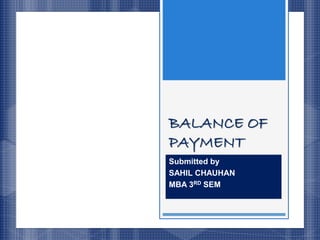Balance of payment presentation sem 3
- 1. BALANCE OF PAYMENT Submitted by SAHIL CHAUHAN MBA 3RD SEM
- 2. CONTENTS B.O.P TRANSFER PRICING DUMPING PRICE ESCALATION BALANCE OF TRADE THEORIES OF INTERNATIONAL TRADE
- 3. INTRODUCTION TO B.O.P Balance of payment is a record of a countryŌĆÖs trade dealing with the rest of the world B.O.P analysis that which country is a strong exporter and importer
- 4. TRANSFER PRICING It Is A Condition In Which One Company Sells Good To Another Company But Both Companies Have Common Ownership. TRANSFER PRICING INCLUDES ŌĆó Market price methods ŌĆó Negotiation The motive is to reduce the tax paid ContdŌĆ”.
- 5. EFFECT OF TRANSFER PRICING It actually relates with multinational companies as they pay high taxation rate. MncŌĆÖs basically deals with more then one country and they have to deals with the different taxation policies
- 6. DUMPING When a firms sell its product lower then its cost of production then it is known as dumping. In the context of I.B.E When one country exports a sizeable amount of goods to another country lower then its cost in domestic country is known as dumping. The W.T.O permits to take action against the dumping both for this the govt. has to prove that dumping is going on.
- 7. CONTDŌĆ” There are many ways to find that the product is dumped heavily or lightly. ŌĆó Price in the exporters market ŌĆó The price charged by the exporter in another country ŌĆó Calculation of the companies normal cost of production including normal profit GATT article 6 allows the country to take action against it by charging extra import duties .
- 8. COMPETITION POLICY Most countries have introduced various regulations to not only promote the competition but also to restrict monopoly practices. For ex HOFFMAN- LA ROCHE
- 9. PRICE ESCALATION Difference between the domestic price and target price in international market. It is basically due to certain reason that causes hike in the price of the product Duties Dealer marginŌĆśs Transportation cost
- 10. Basic structure of price escalation Duty is levied on CIF First markup is on the CIF plus duty value Second markup is on the CIF plus duty plus first markup Dealer mark up is on the CIF plus duty plus first markup plus second markup
- 11. BALANCE OF TRADE Basically it is the difference between imports and exports ŌĆó Price of product manufactured at home ŌĆó Exchange rate and currency fluctuation ŌĆó Regional and other trade agreements both tariff and non tariff ŌĆó Other taxes Factors affecting B.O.P are :-
- 12. Record of India of last few year
- 13. INTERNATIONAL THEORIES These theories explain regarding what, how much and with whom a country should trade. These explanations are given by different economists during different periods MercantilistŌĆÖs Version: Classical Approach: -
- 14. THEORY OF ABSOLUTE COST ADVANTAGE According to this theory the productive efficiency differed among different countries because of diversity in the natural and acquired resources possessed by them. So a particular country should specialize in producing only those goods that it is able to produce with greater efficiency or at lower cost; and exchange those goods with other goods of their requirement from a country that produces those other goods with greater efficiency or at lower cost This theory of absolute cost advantage explains how trade helps increase the total output in the two countries For ex Bangladesh and Pakistan
- 15. Theory of Comparative Cost Advantage Ricardo focuses not on absolute efficiency but on relative efficiency of the country for producing goods. This is why his theory is known as theory of comparative cost advantage. In a two-country, two-commodity model, he explains that a country will produce only that product which it is able to produce efficiently This theory explains that a country should specialize in the production and export of a commodity in which it possess greatest relative advantage.
- 16. Factor Proportions Theory This theory explains that in a two-country, two-factor and two-commodity framework different countries are endowed with varying proportions of different factors of production Some countries have large populations and large labor resources. Others have abundance of capital but are short of labor resources. A country with a large labor force will be able to produce the goods at a lower cost using a labor intensive mode of production Countries with a large supply of capital will specialize in goods that involve a capital intensive mode of production
- 17. THANKS..! !
















